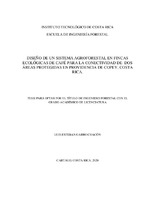Diseño de un sistema agroforestal en fincas ecológicas de café para la conectividad de dos áreas protegidas en Providencia de Copey, Costa Rica.
Resumen
El presente trabajo tuvo como objetivo diseñar un sistema agroforestal en fincas ecológicas de café en el poblado de Providencia, que permita un aumento en la conectividad estructural entre dos áreas protegidas. Por medio de sistemas de información geográfica se determinó el nivel de fragmentación del distrito de Copey a través de la herramienta Landscape Ecology Statistics (Lecos), se obtuvo el índice de uniformidad de Shannon, donde el valor generado fue de 0,601 demostrando que existe una distribución baja y poco homogénea del paisaje afectando la fragmentación en el área de estudio. Para las fincas ecológicas de café se comprobaron las condiciones físicas y ambientales, así como el estado actual en el que se encontraban. Con esta información se procedió a realizar el diseño agroforestal que mejor se adapte a las fincas, de forma que no afecte el cultivo de café y aumente la cobertura forestal del sitio. Para la selección de especies se realizó un inventario forestal con un muestreo sistemático sin estratificar, donde se establecieron parcelas rectangulares de 1000 m2 (20m x 50m), con una intensidad de muestreo del 4%. Con estos resultados se clasificaron las especies forestales y se determinaron las especies más aptas para ser usadas en el diseño. The objective of this work was to design an agroforestry system in ecological coffee farms in the district of La Providencia, which allows an increase in the structural connectivity between two protected areas. Through geographic information systems, it was determined the level of fragmentation of Copey County through the tool Landscape Ecology Statistics (Lecos), it was obtained Shannon uniformity index, where the value generated was 0.601, demonstrating that there is a low and not very homogeneous distribution of the landscape affecting the fragmentation in the study area. For the ecological coffee farms, the physical and environmental conditions were verified, as well as the current state in which they were found. With this information we proceeded to make the agroforestry design that best suits the farms, so that it does not affect coffee cultivation and increases the site's forest coverage. For the selection of species, a forest inventory was carried out with systematic sampling without stratification, where rectangular plots of 1000 m2 (20m x 50m) were established, with a sampling intensity of 4%. With these results the forest species were classified and the most suitable species to be used in the design were determined.
Descripción
Proyecto de Graduación (Licenciatura en Ingeniería Forestal) Instituto Tecnológico de Costa Rica, Escuela de Ingeniería Forestal, 2020
Compartir
Métricas
Colecciones
El ítem tiene asociados los siguientes ficheros de licencia:



